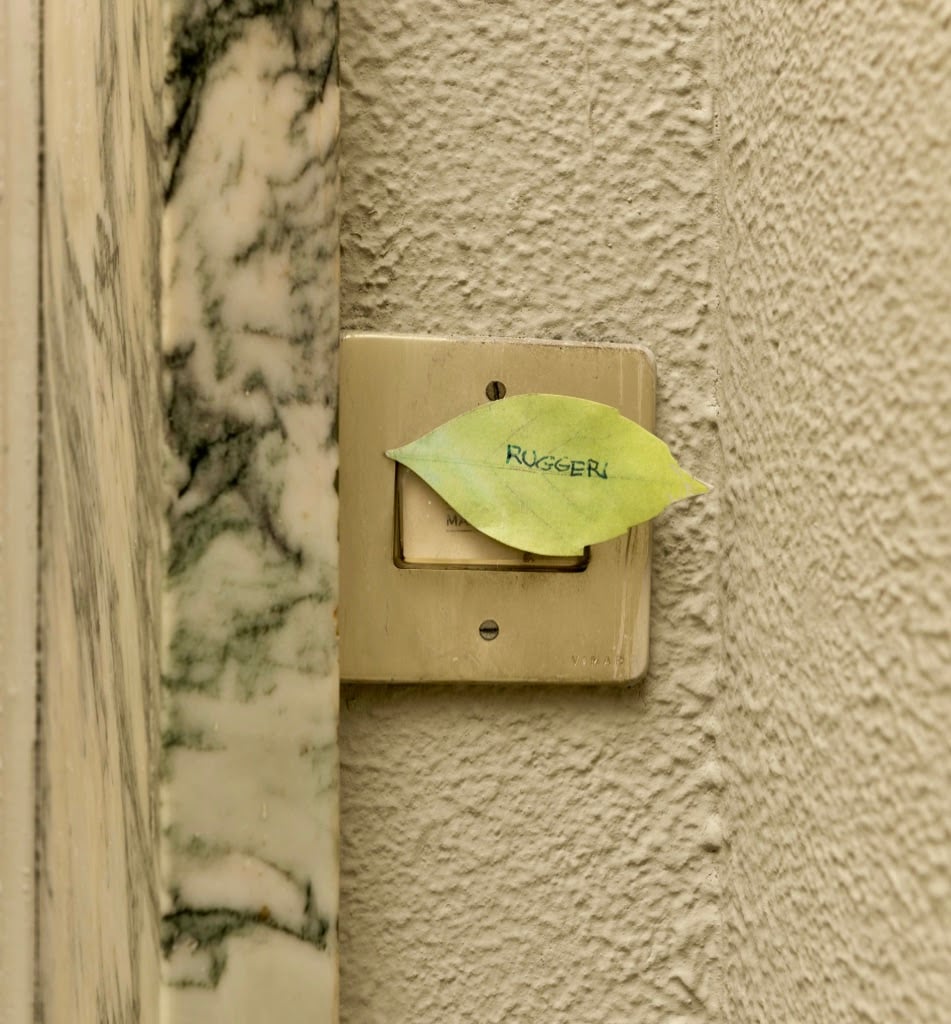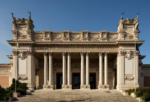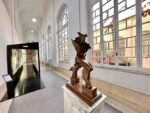Cinzia Ruggeri – …per non restare immobili

Prima personale di Cinzia Ruggeri (Milano,1942-2019) in un’ istituzione pubblica.
Comunicato stampa
Casa Masaccio /Centro per l’arte Contemporanea ha il privilegio di presentare la prima personale di Cinzia Ruggeri (Milano,1942-2019) in un’ istituzione pubblica.
…per non restare immobili, prima mostra di Cinzia “senza Cinzia”, ripristina la destinazione originaria di Casa Masaccio nella dissolvenza di una fantasia domestica facendo del dispositivo spaziale una sorta di macchina per abitare.
Guidata unicamente dalle emozioni e non dalle necessità, eclettica, audace e visionaria, eccentrica ed effervescente, ma soprattutto rigorosa, sin da sempre Cinzia Ruggeri ha innestato con infaticabile voracità, arte, design, architettura e moda, facendo esplodere tutte le loro definizioni. Arredi e ambienti, accessori, abiti come architetture che si indossano ma che soprattutto si abitano, abiti a scale dalle geometrie fluide e abiti ziggurat, la “montagna di Dio” dei Sumeri. Con modulazione lirica ed esistenziale, i suoi oggetti sono impastati di parola, ordinarie cose del quotidiano che, con sottaciuto, ambiguo e sommerso linguaggio, si impongono al di là di ogni abitudine percettiva.
In questa dimora dal trascorso indimenticabile, con passo felpato e irriverente ironia, il mondo di Cinzia Ruggeri si impossessa del silenzio delle stanze e della loro abolita durata, delle categorie timiche come delle tonalità affettive. In una sorta di topofilia, la sua pratica si articola nelle ossa di questa introversa architettura e, tra nenie e ricordi accumulati da generazioni, dimenticanze e passate solitudini, lascia ombre e tracce di un esserci stato.
Ad accogliere il visitatore Il bello delle bandiere è il vento (2018) e l’effige di Scherzi, l’adorato scottish terrier che introduce ai tratti semantici dell’abitare.
Nel living, in un dialogo serrato con la natura, troviamo sparse le malinconiche rovine dell’ultimo elefante che, impossibilitato a riprodursi geneticamente, esplode e si perpetua in oggetti d’uso domestico. Sospeso tra l’organico e l’artificiale, Abito Primavera (1980 ca), con il suo verde aprile ferito da un ramo di pesco, cuce il vento alla terra. E ancora, da un tailleur aspro come le pietre dei muretti a secco, sbucano coccodrilli e fiori.
Nella camera del sonno, lusinghe di vestaglia nel caldo abbuiarsi di una mezza luna egea * e -“un’ombra su cui puoi riposare”- vegliata dall’ armadio pensato in quegli anni trascorsi tra i due mari, là dove la terra finisce e improvvisamente incomincia l’acqua. Ispirato ai colori delle confraternite religiose nelle processioni del Venerdì Santo, il suo cuore trafitto da un pugnale conserva ancora l’odore di salsedine e giardino, mentre le voci della notte sgocciolano risate e parole lasciando penetrare l’alba da altre fessure. Alla “powder room” sono destinate compiacenze d’accappatoio. Tappezzate di spugne di mare, gemme estive e tempestosa devozione al sole, le misure dell’intimo brillano tra la liquida distesa dell’azzurro indifferente di un introvabile abisso. Nella stanza da pranzo, accanto all’antro della profezia di un camino, alloggia l’Abito Tovaglia (1984) che sibillino allunga il suo candore sino a diventare un’estensione del corpo alla funzionalità.
In alto, lassù, all’ultimo piano, come in una sorta di hangar, la rappresentazione della sequenza iniziale di La Règle du Jeu, film di Jean Renoir del 1939, con il duplice schianto al suolo sia dell’aliante che dell’amore tra André e Christine. L’aviatore e l’amante feriti, intanto… un soffitto di nostalgia / nell’aria esplode e un eco si ode…*. La planata di un amore assente, un volo incompiuto come incompiuta L’Arte della Fuga (1747-1750). Si riverbera l’antico vincolo del giorno e della notte mentre il tema dei contrappunti dell’ ultimo Johann Sebastian Bach intreccia le relazioni umane evocate da O Superman (1981), il primo singolo di Laurie Anderson.
Cinzia Ruggeri ci trasporta in volo in un altrove dove la bellezza è preda di un attimo.
Si prega di suonare il campanello.
“..........di oggetti utili che svolgono perfettamente la loro funzione ne esistono a sufficienza; quello che io cerco è il comunicare, l’interagire con loro. Per esempio: un bicchiere con una goccia pendente che partecipa tintinnando quando bevi o un’ ombra sulla quale puoi riposare o una doccia a forma di mano dove l'acqua ti accarezza, così è per gli abiti. anche loro interagiscono con la persona che li indossa. Come l'applicazione di cristalli liquidi che cambiano colore in base alla temperatura del corpo o abiti con led che puoi accendere quando incontri qualcuno che ti piace...
I miei elementi abbastanza ricorrenti sono le uova, i cani, i nasi dei cani, i maiali, le perle, il vetro, le galline, i camaleonti, i polpi, le razze,i nautilus, i fenicotteri e altri soggetti liberi, e poi il velluto, la georgette di seta, il lino…
mi piacciono i capperi, i carciofi in particolar modo, il balletto triadico di Oscar Schlemmer e gli alianti.
…e da sempre ridere e nuotare."
(Cinzia Ruggeri, Febbraio 2019)
*da Aristocratica, Matia Bazar, 1984
Cinzia Ruggeri (1942–2019)
Ha studiato all’Accademia di Belle arti di Brera, Milano. Prossimamente: FUORI, Quadriennale d’arte 2020, Palazzo delle Esposizioni, Roma (2020). Tra il suo repertorio di mostre si menzionano: la règle du jeu?, Galleria Federico Vavassori, Milano (2019); Finché si scherza, Galerie Francesca Pia, Zurigo (2019); Home. A User's Manual, curato da Fredi Fischli e Niels Olsen con Valentina Enhimb, GTA Exhibitions, ETH Zurigo (2019); déconnexion, Campoli Presti, Parigi (2019); Umbratile con Brio, curato da Mariuccia Casadio, Galleria Federico Vavassori, Milano (2018). Tra le recenti mostre collettive: We need more than one term for these big things, curata da Melanie Ohnemus, University of Applied Arts, Vienna (2019); The Estate Summer, Kim? The contemporary Art Center, Riga (2019); Lost in the Pool of Shadows, curata da Luca Lo Pinto, Emanuel Layr, Roma (2019); Article 132–75, The Art Side of Kartell, curata da Ferruccio Laviani e Rita Selvaggio, Palazzo Reale, Milano (2019); Tra l’inquietudine e il martello, Galleria Federico Vavassori, Milano (2018); ITALIANA. L’Italia vista dalla moda, 1971–2001, curata da Maria Luisa Frisa e Stefano Tonchi, Palazzo Reale, Milano (2018).
...per non restare immobili è stata possibile grazie ai contributi filologici e iconografici di Aldo Lanzini e al supporto della Galleria Federico Vavassori (Milano). In collaborazione con Kunstverein di Langenhagen (G), dove la mostra sarà presentata in una versione adattata nella primavera 2021.
Progetto realizzato nell’ambito di Toscanaincontemporanea2020
________________________________________________
Casa Masaccio/Centro per l’Arte Contemporanea has the privilege of presenting the first solo exhibition by Cinzia Ruggeri (Milan, 1942-2019) in a public institution.
...so as not to stand still, the first exhibition of Cinzia’s work ‘without Cinzia’, restores Casa Masaccio to its original use through the dissolve of a domestic fantasy, turning the spatial system into a sort of machine for living.
Guided solely by her feelings and not by needs, eclectic, daring and visionary, eccentric and effervescent, but above all rigorous, Cinzia Ruggeri always coalesced art, design, architecture and fashion with indefatigable voracity, blowing all their definitions to smithereens. Furniture and settings, accessories, clothes like works of architecture that can be worn but above all lived in, clothes like stairs with fluid geometries and clothes in the form of a ziggurat, the Sumerian ‘mound of god’. With lyrical and existential modulation, her objects are concoctions of words, ordinary, everyday things that, with unstated, ambiguous and subdued language, claim attention above and beyond any habit of our perception.
In this abode with an unforgettable past, the world of Cinzia Ruggeri has taken possession, with stealth and irreverent irony, of the silence of the rooms and their abolished duration, of thymic cathegories as well as affective tonalities. In a sort of topophilia, her practice is set out in the bones of this introverted architecture and, between lullabies and memories accumulated for generations, oversights and past solitudes, leaves shadows and traces of having been there.
Visitors are greeted by Il bello delle bandiere è il vento (The Beauty of Flags is the Wind, 2018) and the effigy of Scherzi, the beloved scottish terrier who introduces them to the semantic traits of dwelling.
In the living room, in a close dialogue with nature, we find scattered the melancholic ruins of the last elephant which, prevented from reproducing genetically, has exploded and is perpetuated in objects of domestic use. Suspended between the organic and the artificial, Abito Primavera (Spring Dress, c. 1980) with its April green wounded by the branch of a peach tree, sews the wind to the earth. And again, from a suit as rough as a dry-stone wall, spring crocodiles and flowers.
In the sleeping room, dressing-gown allurements in the warm darkening of an Aegean crescent moon* and ‘a shadow which you can lie down on’, watched over by the wardrobe she thought about in those years spent between the two seas, there where the land ends and the water suddenly begins. Inspired by the colours of the religious confraternities in Good Friday processions, its heart transfixed by a dagger, it still holds on to the odour of salt spray and garden, while the voices of the night drip laughter and words, letting the dawn enter through other cracks. To the ‘powder room’ are assigned bathrobe pleasures. Plastered with sea sponges, summer gems and stormy devotion to the sun, the measures of the intimate shine amidst the liquid expanse of indifferent blue of an untraceable abyss. In the dining room, alongside the cave of prophecy of a fireplace, lives the Abito Tovaglia (Tablecloth Dress, 1984) that spreads its whiteness in sibylline fashion until it becomes an extension of the body to functionality.
Above, up there on the top floor, as if in a sort of hangar, the representation of the opening sequence of La Règle du Jeu (The Rules of the Game), a film made by Jean Renoir in 1939, with the dual crashing to the ground of the glider and of the love between André and Christine. The aviator and his lover wounded, in the meantime... a ceiling of nostalgia / explodes in the air and an echo is heard...* The glide of an absent love, a flight as incomplete as The Art of Fugue (1747-50) is incomplete. The ancient bond of the day and the night reverberates while the theme of Johann Sebastian Bach’s late counterpoints interweaves the human relations evoked by ‘O Superman’ (1981), Laurie Anderson’s first single.
Cinzia Ruggeri takes us on a flight to an elsewhere in which beauty is the prey of an instant.
Please ring the doorbell.
“..........there are already plenty of useful objects that perform their function perfectly; what I’m looking for is a way to communicate, to interact with them. For example: a glass with a pendant that joins in when you take a drink by clinking against its side or a shadow which you can lie down on or a shower in the form of a hand with which the water caresses you. The same for clothes. They too interact with the person wearing them. Like the application of liquid crystals that change colour on the basis of the body’s temperature or clothes with LEDs that you can make light up when you meet someone you like...
Fairly recurrent elements in my work are eggs, dogs, dogs’ muzzles, pigs, pearls, glass, hens, chameleons, octopuses, rays, nautiluses, flamingos and other free spirits and then velvet, silk georgette, linen...
I like capers, and artichokes in particular, Oscar Schlemmer’s Triadic Ballet and gliders.
...and I’ve always loved laughing and swimming.
(Cinzia Ruggeri, February 2019)
* from ‘Aristocratica’, Matia Bazar, 1984
Cinzia Ruggeri (1942–2019).
Studied at Accademia di Belle Arti di Brera, Milan. Forthcoming: FUORI, Quadriennale d’arte 2020, Palazzo delle Esposizioni, Rome (2020). Recent solo exhibitions include: la règle du jeu?, Galleria Federico Vavassori, Milan (2019); Finché si scherza, Galerie Francesca Pia, Zurich (2019); Home. A User's Manual, curated by Fredi Fischli & Niels Olsen with Valentina Enhimb, GTA Exhibitions, ETH Zurich (2019); déconnexion, Campoli Presti, Paris (2019); Umbratile con Brio, curated by Mariuccia Casadio, Galleria Federico Vavassori, Milan (2018). Recent group exhibitions include: We need more than one term for these big things, curated by Melanie Ohnemus, University of Applied Arts, Vienna (2019); The Estate/Summer, Kim? The Contemporary Art Center, Riga (2019); Lost in the Pool of Shadows, curated by Luca Lo Pinto, Emanuel Layr, Rome (2019); Article 132–75, The Art Side of Kartell, curated by Ferruccio Laviani and Rita Selvaggio, Palazzo Reale, Milan (2019); Tra l’inquietudine e il martello, Galleria Federico Vavassori, Milan (2018); ITALIANA: Italy through the Lens of Fashion, 1971-2001, curated by Maria Luisa Frisa and Stefano Tonchi, Palazzo Reale, Milan (2018);
...so as not to stand still has been made possible by Aldo Lanzini’s suggestions for the reconstruction of the iconography and by the support of the Galleria Federico Vavassori (Milan). In collaboration with Kunstverein in Langenhagen (G) where the exhibition will be shown in an adapted version (spring of 2021).
Project carried out as part of the initiative Toscanaincontemporanea2020.
________________________________________________
Ringraziamenti / Acknowlegments:
Angus Fiori (Archivio Cinzia Ruggeri, Milano)
Aldo Lanzini
Federico Vavassori e Laura Salvo (Galleria Federico Vavassori, Milano)
Emanuela Campoli (Campoli Presti, Parigi/Londra)
Francesca Pia (Galerie Francesca Pia, Zurigo)
Benedetta Pesci e Michele Stacchini (Poltrona Frau S.p.a.)
Fredi Fischli, Niels Olsen, Valentina Enhimb, gta Exhibitions, ETH Zurigo
Georg Brintrup
Anna Battista
Mariuccia Casadio
Elena Fava
Tiziana Paini



